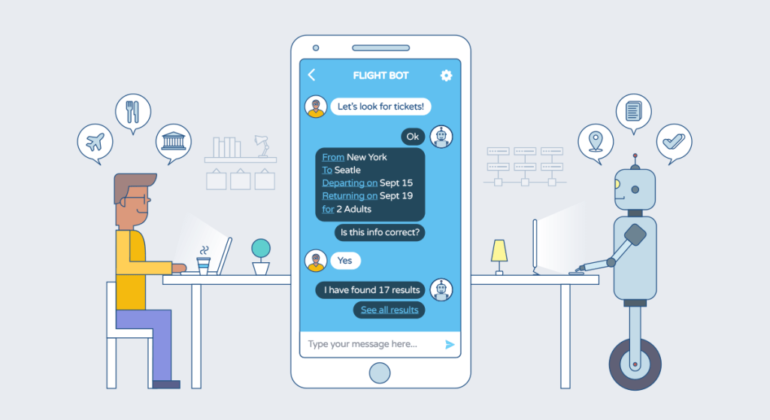A conversational web site is an intelligent web site that uses a conversational interface to communicate with visitors, here
a chatbot facilitates conversation with users
. A bot and a user go back and forth with a series of closed-ended questions. In other words, a bot is a medium for conversation between a website and a user. And depending on the user’s input, the bot acts on the website.
A conversational website can drastically improve the performance of e-commerce companies. It helps create a better way for brands to interact with their customers online and improves user engagement and customer satisfaction.
In recent years, and especially throughout 2020, more and more customers have moved to digital channels. Even those who used to shop offline feel confident about e-commerce and have made the switch to online stores. For this reason, it is time to use artificial intelligence technology and adapt to the flows and habits of users to make online shopping interactive and more fluid.

People love to text
Messaging has become an important means of communication in recent years. According to the Statistic Brain Institute, in the U.S., the number of text messages sent and received monthly has increased by 7% in the last decade.
People tend to prefer to communicate by text message, with friends, family, but also with companies. Sending messages is easier and faster than making a phone call or sending an e-mail. For that reason, branded massage is an always-available communication option that many customers appreciate.
Most customers already interact with chatbots. According to the UserLike study, 80% of respondents have interacted with a chatbot before. Consumers are more comfortable with the idea of chat support and service now than they were a few years ago. In particular, Generation Z and Millennials are more willing to communicate with brands through a chatbot.
A conversational design enables communication between the website and the user through a chatbot, making the shopping experience more personalized.
Easy page navigation
Visitors to e-commerce websites waste a lot of time searching for what they want. Navigation can be much easier on a conversational e-commerce website with a chatbot that handles the user’s search. It avoids the user having to go through endless menus and filters.
A chatbot sees what the user sees and displays what the user tells the bot to display. Turn tedious and time-consuming website navigation into conversational and engaging product search and filtering.
To illustrate, when a customer asks a bot about a product, it can display cards with thumbnail images, a description, a link to each product page, a video or other visual content. You can also offer several products in a customized window and navigate to the user.
When a user arrives at a landing page, a chatbot can start the customer journey by asking “How can I help you today?”¨. The user’s answers may be: “I’m looking for floral perfumes for women”, and the chatbot’s response may be something like “I’m happy to help! Here is the complete list of all the floral fragrances for women in our store.
Solving the shopping cart abandonment problem
Purchasing decisions tend to be emotional, and if a consumer begins to doubt the products in their shopping cart, they will either cancel the order or simply leave the website. More than two-thirds of all online shopping carts end up being abandoned.
Often, customers need advice on whether they are making the right decision. Current e-commerce website design has limited capabilities to encourage customers to close the purchase. A big, bright, large call button is not enough.
When a customer fails to checkout after spending a long time on the website, a chatbot widget can pop up and remind the customer about the items in the basket or encourage them to buy again.
You can help the buyer by saying, for example, “Any questions about how this shirt will fit? Let me help you with sizing! “, or “I love this shirt too – have you seen that there are only 3 in stock? “, or “Can I show you this shirt in a different color? “.
Many e-commerce companies try to recover abandoned shopping carts and send an e-mail reminder. However, this method does not appear to be effective. Many customers don’t even open these emails.
However, a conversational website can encourage the shopper to make the purchase in real time or gather useful information about why a customer doesn’t want to proceed. For example, you can ask, “Was the price too high? ¨,or “Is the shipping time too long? ¨
Commonly, users lack the information to make the final decision. A chatbot can help find the details the customer needs from the website that will ensure they have what they want.
(Source: botxo.ai)
Visit our Facebook page
here
.

